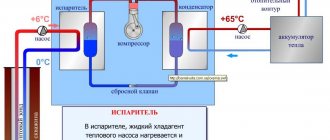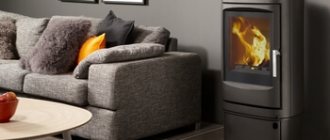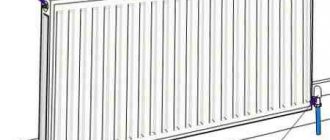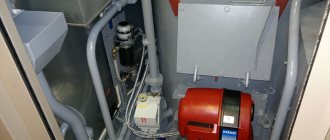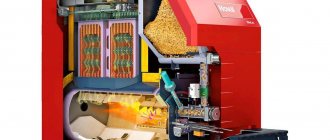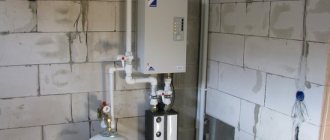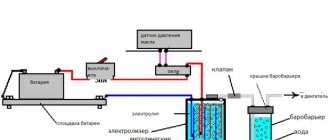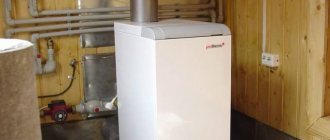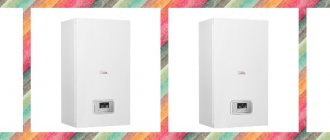Some heating boilers use solid fuel as fuel - coal, firewood, pellets and briquettes. Each type of solid fuel differs in its characteristics, heat capacity and combustion duration. In industrial and domestic heating boilers, coal is often used as fuel. This type of fuel is valued for its high heat capacity and good heat transfer. There are several types of coal. Moreover, not all of them are used for combustion in the heating equipment of a private home.
Pros and cons of heating with coal
Coal for heating has the following advantages:
- After one addition to the boiler, this fuel burns for 10-12 hours.
- Good heat dissipation. This indicator may differ slightly for coal of a certain fraction and variety.
- This is a universal type of fuel that can be used in various heating devices (portable stoves or stationary boilers).
- The reasonable price of fuel is another advantage.
- Coal is easy to transport and store.
- To operate this type of fuel, you do not need to build a gas pipeline or connect other networks to the unit.
- Coal has a high heat capacity, which additionally helps maintain the air temperature in the room.
- To heat a room, a minimum portion of solid fuel is sufficient, because it has good heat transfer.
The disadvantages of using coal to generate heat for the purpose of heating the coolant are the need for human participation to put fuel into the boiler or furnace. This disadvantage is solved by using automatic feeding systems. After combustion of this type of fuel, ash accumulates in the boiler, which must be cleaned out regularly. Coal can only be stored in a dry place. In order for fuel to burn efficiently, it is important to have draft in the chimney. You will also need wood chips or firewood to ignite fuel.
Charcoal KAMADO
Japan is ahead of the rest. And the Japanese have shown themselves to be very good in the production of grill fuel. The idea was to produce ideal coal from “artificial wood”, which was denser than all known types of wood. Dense briquettes are obtained from sawdust under the influence of high pressure and temperature, without additional binders. The resulting coal is of high quality, has the highest temperature and burning time (up to 6 hours). The disadvantage of this type of coal is that it is difficult to ignite. Use a starter mug for these purposes.
Summarize. Heavy charcoal is ideal for grilling meat. Therefore, experienced grillers prefer compressed coal briquettes, which maintain a consistently high temperature. The main rule: pay attention to the composition of the coal, it must be natural, without alcohol, kerosene or glue. The binder can be natural starch, as in Weber brand coal, or without a sealant at all, as in Kamado coal.
Types of coal used for heating
To understand which coal is best for heating a home, you need to consider all the varieties of this fuel.
There are the following types of coal fuel:
- Long-flame stone variety. This is a fairly popular type of fuel, which is often used in heating systems of private houses. This type is suitable for use in various heating devices and comes in graded and ordinary types. Its advantages are good heat transfer and long burning. Ignition occurs with a minimum amount of wood, and combustion does not require blowing.
- The low-caking stone type is a coking fuel that has an increased level of metamorphism. It is not used in private heating systems due to its high cost. Typically used for heating large public, educational and medical institutions. The fuel takes a long time to ignite, but has high heat transfer. This type of coal does not burn or smoke; it smolders for a long time, releasing heat for a long time. When answering the question of which coal burns longer, we can name this type.
- The best coal for the boiler is anthracite. This type of fuel can be distinguished by its characteristic gray-black hue with a metallic sheen. The product is similar in strength to stone. Due to the high carbon content (95%), the fuel burns almost completely in the firebox, without emitting odor or smoke, and leaving a minimum of ash. Another advantage of fuel is its reasonable cost.
- Another variety is peat coal, which is formed by combining bitumen masses with the remains of rotted plants. This natural resource is supplied in briquettes. Charcoal briquettes cannot boast of high calorie content, which reaches only 6000 kcal, and have reduced heat transfer. The advantages are low dustiness and reasonable price. Although briquettes burn quite efficiently, they will need to be refilled frequently.
- Brown coal is a solid fuel that has a second stage of metamorphism. This type of product is an intermediate link between peat briquettes and anthracite.
Safety rules for burning a fireplace
Where there is fire you need to be as careful as possible. When lighting a fireplace, you should follow several rules:
- Monitor the condition of the firebox and chimney. They must be free of cracks and not dirty. If you use the fireplace often enough, a lot of soot and soot will form on the walls of the air duct over time. Because of this, the chimney draft will become less, and sooner or later smoke will begin to penetrate into the room. And as we know, carbon dioxide is dangerous for humans and animals. Getting a fire or getting poisoned is a dubious prospect.
- The fireplace should be lit gradually. First, small logs are lit, and only after they have burned out sufficiently can the amount of fuel be increased. If you think that you can put fuel in the fireplace and the flame will burn brighter, you are mistaken. All the heat will simply go into the pipe, and not into the heating.
- There is no need to fill the firebox to the top with fuel, as the walls of the fireplace may be damaged. At best, this will shorten the life of the stove, at worst, it will lead to a fire.
- While fuel is burning in the fireplace, the damper that regulates the draft in the fireplace must be slightly open.
- Do not throw trash, painted logs, or add flammable liquids into the fireplace. The smoke from such substances is toxic and can lead to poisoning.
Coal marking
To choose the right type of fuel for heating a private home, you need to know the brands of coal for household boilers. Different types of coal fuel are designated by letters.
Types of heating briquettes and their characteristics
Letter markings are deciphered as follows:
- the letter A stands for anthracite;
- letter B is brown coal;
- the letter G means gas;
- D – long-flame variety;
- K – coke type;
- F – fatty variety;
- OS – sintered lean;
- SS is a low-sintering variety;
- T is for skinny.
Coal of the first brands is suitable for household heating appliances; you should not buy lean varieties with low heat transfer. Coal markings consist of letters.
The first letters indicate the type of fuel, and the second letters indicate its size:
- The letter Ш (piece) is coal with a fraction of no more than 6 mm.
- The letter C (seeds) characterizes fuel with a fraction in the range of 0.6-1.3 cm.
- Marking M (small) is a small fuel with a size of 1.3-2.5 mm.
- The letter O (walnut) characterizes the material with a fraction of 2.5-5 cm.
- Marking K (large) - these are elements measuring 5-10 cm.
What coal is best to use?
The best option for use in stoves made of various materials is anthracite. It is usually marked with the letter “A”. Another grade “D” belongs to long-flame stone. Based on the size of the granules, it is designated by various symbols.
| Designation | Granule size in mm |
| Fuel with large fractions - “K” | 50-100 |
| Walnut "O" | 25-50 |
| Small "M" | 12-25 |
| Seed "C" | 6-13 |
| Slab coal, with large fractions “P” | Over 100 |
| "R" mixed coals |
Choosing a type of solid fuel for heating
Now let's talk about how to choose coal for heating a private home. Anthracite is best suited for heating a large individual building. This fuel has minimal consumption with maximum heat transfer, burns evenly and for a long time, and does not leave a lot of residue. Another advantage of using this fuel is that it does not clog the chimney, facilitating longer operation of the system.
The disadvantages of using anthracite are its high cost and difficult ignition. To reduce the cost of purchasing fuel, you can buy a long-flame variety. This type is suitable for use in any heating equipment that runs on solid fuel. Long-flame coal ignites easily and quickly, burns well and for a long time. One bookmark is enough for 10-12 hours of equipment operation. For good combustion, minimal airflow is ensured.
Gas fireplace
A gas fireplace without a chimney has many advantages and undoubted conveniences. Heating rooms with gas is undoubtedly an effective and simple method, but quite expensive. For example, for 85 hours of combustion, one cylinder of liquefied natural gas and propane-butane is required. Heat transfer during gas combustion is 2.5 times higher than when using solid fuel.
But when heating a stove or fireplace in a house with gas, it is important to know, remember and follow the safety rules:
- Gas cylinders must be placed in a separate isolated room with a forced ventilation system. This way, if a gas leak occurs, the ventilation will quickly remove the gas. Accordingly, the larger the cylinder, the more powerful and serious the ventilation should be.
- In the room where the fireplace is located, special sensors must be installed to warn of increased gas concentrations in the air. If necessary, the automatic gas supply shutoff system should operate.
- Connection and debugging of the fireplace should only be carried out by certified specialists. Obtain all permissions from relevant organizations.
Determination of coal consumption
To determine the consumption of solid fuel, you need to know the area of the building, the quality of insulation of the enclosing structures, as well as the air temperature outside and the type of boiler. To heat a brick house you will need the most coal. The same construction made of wood requires 30% less fuel.
Heating stoves and boilers for the home with a water circuit
To maintain a comfortable temperature during the heating season in a cinder-concrete house with walls 45 cm thick and an area of no more than 90 square meters, you will need approximately 3-3.5 tons of coal per year. These indicators are valid for stove heating. For the same buildings made from other materials, up to 8 tons of product are purchased for one heating season. However, in regions with a mild climate, this consumption can be reduced by 1/3.
To determine the fuel consumption for a new house, you need to buy coal in bags and warm up the boiler or furnace equipment well, noting the time it takes for the fuel to burn completely. You also need to record the temperature in the house. When calculating consumption, it is important to take into account the efficiency of the heating system, the outside temperature and the draft in the chimney.
On a note! When purchasing coal for the first time for a home heating system, fuel is purchased with a reserve. Buy WPC, not the brown variety, which loses its properties when stored for a long time.
Types of solid fuel boilers
traditional fuels,
- The first type of boiler is called cast iron. It is designed to burn fuels such as coal and wood. Despite all its positive aspects, it is still dependent on people and energy supply. Wood in such a boiler usually burns for no more than 5 hours, which means fuel must be constantly added. Currently, domestic and foreign manufacturers produce such boilers, some of them are called KChM and Solida.
- The second type differs in many ways from the first and is called pyrolysis heating boilers. There are two combustion chambers, in one of which the fuel immersed in the boiler burns, and in the second the gas synthesis burns out. The main type of fuel is wood. It has a longer burning time than a cast iron boiler; here it is 10 hours. One of the most successful boilers of this type is called Dakon, made in the Czech Republic.
- Pellet boilers, the name comes from the word pellets (granulated wood). It is she who needs to heat the room using such boilers. It has a convenient additional advantage - it independently adds the required amount of fuel using an auger and ignites it. The burning time in this case depends on the boiler model and the capacity of its hopper. But there is also a significant drawback - you cannot burn anything except wood pellets in such a boiler.
- The most modern and popular type is long-burning boilers. Firewood, sawdust, coal, and peat can be used as fuel. They surpass their analogues in combustion time; with such a boiler no human intervention is needed for 2 days or more thanks to the latest top-down combustion system, this allows the fuel not to burn, but to smolder for a long time.
Solid fuel boilers are a good alternative to gas. If you live in a country house or your street is not gasified, a long-burning boiler using coal, wood and other fuels will perfectly heat a room of any size.
How to choose a solid fuel boiler
When choosing a boiler, you should pay attention to the following criteria:
- boiler design;
- principle of operation;
- power;
- type of raw materials used;
First of all, you should pay special attention to power. This is one of the most important criteria and the operation of the boiler depends on it, since not every model can cope with a home heating system that is too large
You need to check the power of the boiler with a specialist; he will compare criteria such as the area of the house, the climatic region and even the height of the ceilings. The approximate required power can be calculated independently based on the following rule: 1 kW of power is required for 10 square meters.
An error in choosing the boiler power can have a bad effect on the quality of heating. With a lower degree of heating, the room will be cold, and with a higher degree, the equipment may fail.
Boiler installation location
separate room. separate boiler room
Three important rules when choosing a boiler installation location:
Ventilated area. If additional gas is used as fuel, a slight leak may occur. If the installation is done correctly, there is no need to be afraid of leaks, but if they accumulate for a long time, there is a high probability of poisoning.
Deep cellar. Not the easiest option for installing a boiler, but still, if the house has the opportunity to install it at a depth of 2 - 3 meters from the heating radiator, this would be an ideal option
Thanks to this installation, no additional circulation is needed, you don’t need to use circulation pumps, but if the installation option is only in the house, circulation is required, if it is missing or installed incorrectly, carbon monoxide can leak, it is impossible to determine its presence in the room without special devices, and you can be poisoned by it easily.
Chimney. It is important to provide the necessary draft. If these calculations are incorrect, the boiler power may be reduced and combustion products may enter the room.
The installation of the chimney must be carried out by a specialist, since it is easy to make a mistake in this difficult task and lose heat.
If all rules are followed, the solid fuel boiler will work properly for many years.
Coal storage rules
Adhere to the following rules for storing solid fuel:
- During long-term storage, solid fuel erodes and oxidizes. The same happens to it due to exposure to precipitation when stored in an open area. Therefore, do not purchase too much product and store it indoors.
- The temperature in the storage area should not exceed +20°C, otherwise the material will soften and crack.
- During long-term storage and signs of oxidation appear, solid fuel is wetted to reduce the risk of ignition and increase strength.
- For storage you will need a well-ventilated room that is not exposed to sunlight or precipitation. A barn with one open wall on the north side is suitable for these purposes. To protect against precipitation, the product is covered with hygroscopic material.
Why does coal burn poorly in a boiler?
For efficient combustion of solid fuels, access to oxygen and a certain temperature are required. It is also important not to violate the rules of ignition. Before each loading, the furnace is cleared of ash, then the wood is lit and after it burns well, a portion of medium-fraction coal is added. After this fuel has warmed up well, you can add larger pieces.
Fuel may burn poorly due to insufficient or no draft. To increase the access of oxygen to the combustion chamber, the area underneath is cleared and the exhaust pipe is extended. The oxygen supply must be from below, so the space under the firebox must be cleared of debris and ash.
Another reason for poor fuel combustion may be the presence of dust. To reduce the dustiness of the material, briquettes are made from it. To do this, the layers are wetted before loading. As a result, the dust will be compressed and the material will burn faster.
Also, the cause of ineffective combustion may be the use of a low-quality product. Sometimes the caloric content of fuel does not correspond to the declared value. Briquettes can also be formed from coal, which has already lost its quality characteristics.
An excursion into the history of the emergence of coal
To better understand the issue, let’s dive into history. Perhaps our ancestors, who cooked food over an open fire, can easily be called the pioneers of barbecue. The first devices for cooking over fire, according to scientists, appeared about 5 thousand years ago. There is also evidence of the use by American Indians (even before colonization) of devices similar to the modern lattice. A structure made of sticks and branches placed on a fire for frying meat was called “barbacoa,” which gave the name to modern “barbecue.” The fashion for grills as we know them today was introduced by America. After the end of World War II, the massive construction of country houses began in the States, and with them the arrangement of garden kitchens, led by barbecues. At the same time, there was a special interest in charcoal as a “fuel” for outdoor cooking.
Coal stoves for home heating from
Lokomotiv coal-fired home stoves, developed by our engineers, demonstrate the optimal combination of cost, functionality, durability and safety. You can buy two models of different capacities from us: for rooms with a volume of up to 120 m3 and up to 200 m3. Among the advantages of the equipment are:
- "Omnivorousness."
The stoves operate on wood, fuel briquettes and coal. To change the configuration of the internal space of the firebox, replaceable inserts are installed in it. - Possibility of heating food.
The oven is equipped with a hob. - Steel casing.
The stove is equipped with reliable protection from intense thermal radiation and is characterized by increased fire safety.
For advice on the installation and operation of Lokomotiv stoves, please contact the employees or the nearest authorized service center.
Basics of yard design and landscaping
1. Taking into account the characteristics of the territory. With the help of modern technologies and the professionalism of workers, it is possible to make the entire site level, which will require a lot of physical and financial investments. But is it worth breaking all this?
After all, in place of a hill you can build a beautiful and modern alpine slide, and in the depression there is a transparent reservoir. But if the differences are simply huge, then you can use the services of a vertical planning specialist who will make the desired picture for you and turn it into reality.
2. Harmony with the building and various small structures. The design of the courtyard of a private house should be adjusted to the structure itself, which plays a dominant role. With the help of landscaping, you can hide outbuildings and create a beautiful approach to the main element on the territory. The opening of the view of the front of the house should be smooth and organic.
3. Functionality - this means planning the territory by zones. It all depends on the preferences of the owners, their type of activity, and the presence of children.
For example, the following zones should be present: front (entrance), utility (orchard), quiet recreation, sports, active recreation, children's area (if there are children), and others. The breakdown is made in advance, carried out by the road and path network system.
4. Visibility of the territory. It is necessary to think in advance about how the yard looks from all the windows and balconies. After all, even while at home, you can admire the open views.
It is not at all interesting if from the bedroom the owners watch the place for drying clothes, or the car standing peacefully in the parking lot. It’s more pleasant to look at a beautiful landscape design, pond or sculpture.
5. Lighting will help diversify and make your yard beautiful. You can play with light throughout the entire area.
Thinking through this process is very important. For example, illuminated paths with small lamps, or the use of special lanterns built into tiled paving.
6. Gardening and landscape design. A lot depends on these processes - this includes leisure, a person’s internal perception of the environment, and the aesthetics of the yard. Also, such processes are the final stage of design and improvement.
Preparing the stove and burning coal
Before starting kindling with coal, it is necessary to inspect the stove for serviceability and carry out some preparatory procedures.
This is especially important for dachas, where the owners are not present often, and the stove has been idle for a long time:
- You need to carefully inspect the stove for cracks in the masonry. If they are, then smoke and carbon monoxide may enter the house. As temperatures rise, cracks can become larger and cause even more damage to the masonry. Cracks must be sealed with a mixture of clay and sand.
- It is worth inspecting the chimney (attic and roof) for the presence of whitewash.
- It is not recommended to leave flammable and easily flammable objects closer than 1.5 meters from the hot walls of the stove. And also place dried firewood close to the stove.
- With constant use, it is necessary to clean the pipe 2-3 times a month.
- The stove must be cleaned before lighting. Slag and ash are poured with water and scooped out with a poker, removing them from a specially designated area. The outside of the stove must be cleaned of dust with a dry cloth, otherwise there will be an unpleasant smell in the room.
- Do not use pieces of bitumen, construction and agricultural waste, or plastic for kindling.
- It is not recommended to open the vent and the stove door at the same time.
- To prevent the stove from overheating, it is heated a couple of times a day for no more than two hours.
- Coal is used dry, medium size. It is cleaned of dust and dried.
Under no circumstances should you use kerosene, gasoline or similar flammable liquids for kindling.
Do not leave the stove unattended during heating periods. Especially if there are children or animals in the room.
Now, as for kindling with coal:
- The first thing you need to do is clean the stove from soot and ash and prepare the coal.
- A layer of crumpled newspapers or paper is placed on the bottom of the combustion chamber, and a layer of small wood chips is placed on top.
- Small dried logs, for example birch, are placed on the wood chips. For better combustion, the firewood is laid in a “well” or “hut” and leaves space between them for good air circulation.
- You can set fire to newspapers with regular matches, as well as with a special spray can.
- The oven door is closed. The blower is opened. With its help, the strength of the flame is regulated. Accordingly, the more air enters, the more intense the fire in the stove.
- When the logs burn, a layer of hot coals appears. A layer of fine (about 15 cm) coal is poured into the stove.
- If the furnace door opens, then the vent should be closed.
- After good combustion, the coal must be added up to 60 cm (coarse fraction).
At the moment of flaring, the coals need to be stirred a little to improve air circulation and prevent the mass from baking.
Coal is added through the combustion door or through the shifted burners of a metal stove (this option is considered more convenient and safe).
https://youtube.com/watch?v=7HkjdAuxcCo
It is not difficult to purchase coal or anthracite in Russia - you can purchase it either in one small bag, or in large quantities at once, placing an order for delivery directly to the storage location.
Heating with coal in bags is especially popular among residents. And this is due to the fact that purchasing packaged fuel is very convenient. It is easy to transport and store, it does not get dirty and crumble as much as loose coal.
If you have a stove at home, or are planning to build it, or buy it, then you will probably be faced with the question of how to heat it.
Coal is a rock. Origin: plant world. This rock is flammable, that is, fuel. The main element of the structure is carbon.
Coal is considered the most economical type of fuel after gas. It has an advantage over wood in that it requires less heat to produce the same amount of heat. It also weighs less than wood, is more efficient for heating, and is easier to transport.
As a child, we lived in a private house and burned the stove with coal in the winter. At that time, we did not know what kind of coal there was, however, it was possible to determine by eye that there are different types of coal.
Sometimes the coal simply did not want to flare up and it took a lot of wood to light it. Such coal produced little heat, and a lot of slag remained after combustion. In addition, it differed in color.
Sometimes my father managed to buy a car of beautiful black coal, its edges sparkling in the sun. This coal burned perfectly, almost did not smoke, easily flared up and burned, leaving behind only a handful of ash, with a small amount of solid slag.
After the stove was lit, we loved to sit right there in the kitchen, read science fiction, and watch mom prepare dinner.
Coal classification
TOP 5 pellet boilers
If you still don’t know which solid fuel boiler is best to purchase for heating your home, we strongly advise you to take a closer look at pellet heating devices. Installing such a unit will allow you not to look into the boiler room at all for several days. There can be only two difficulties here:
you need to have enough places to store pellets; Such fuel material is not available in every region.
If you don’t foresee any difficulties with purchasing and storing pellets, such a boiler will definitely allow you to appear in the furnace room as little as possible.
Zota Pellet 25
One of the most popular and expensive devices is the ZotaPellet boiler. This cutting-edge unit is equipped with a liquid crystal display and is capable of controlling as many as five pumps simultaneously. Literally everything can be connected here - from underfloor heating to a centralized heating system. A power of 25 kW is quite enough for high-quality heating of a house with an area of at least 250 m2.
Pros:
- Efficiency more than 90%;
- electric ignition;
- high energy efficiency;
- reliable automation;
- high-quality thermal insulation;
- multifunctionality.
Minuses:
considerable cost, about 3300 USD. e.
Biomaster BM-15
Here is another high-quality boiler that runs on pellets. This model is good for heating a large house. Depending on the configuration, it may have a loading hopper of 200 or 400 liters. Equipped with an automatic ash removal system.
Advantages:
- absolutely not demanding on the quality of the pellets used;
- good efficiency;
- efficiency;
- ease of installation and comfort of use.
Flaws:
- cost from $2,800;
- has a lot of weight;
- requires a foundation.
Teplodar Kupper OK 30
And this unit is generally “omnivorous”. Teplodar Cooper, although it has much fewer bells and whistles, is absolutely not demanding on the quality and type of fuel. Compact dimensions allow you to comfortably place fuel equipment on an area of about 5 square meters. meters.
Pros:
- Efficiency over 89%;
- high-quality thermal insulation;
- compact dimensions;
- variety of fuels;
- automatic fuel supply;
- automatic adjustment of t˚C mode;
- ease of operation;
- low price, from $600.
Minuses:
difficult to install on your own, requires the involvement of a specialist.
Pelletron
There are only 2 modifications of boilers from this company: 40 and 20 kW, which allows you to perfectly heat rooms up to 700 or 400 m2, respectively. The cost of Pelletron pellet boilers can reach 1,500 conventional units, depending on the power.
Advantages:
- Efficiency up to 92%;
- compact dimensions;
- light weight;
- equipped with a smoke exhaust system, which allows you to do without chimney equipment;
- has automatic protection against fire or overheating.
Flaws:
- has inflated requirements for the quality and size of pellets;
- If installed and used incorrectly, fire may spread into the bunker.
Kiturami KRP 20-A
An interesting model of a pellet boiler - it can provide not only heating of the room, but also additional provision of hot water to the home.
Pros:
- auto-dosing of fuel;
- presence of a thermostat;
- possibility of heating water;
- ease and accessibility of cleaning the ash pan;
- ease of installation;
- spacious fuel bunker;
- Automatic protection against freezing or overheating.
Minuses:
price, about 3,500 US dollars.

